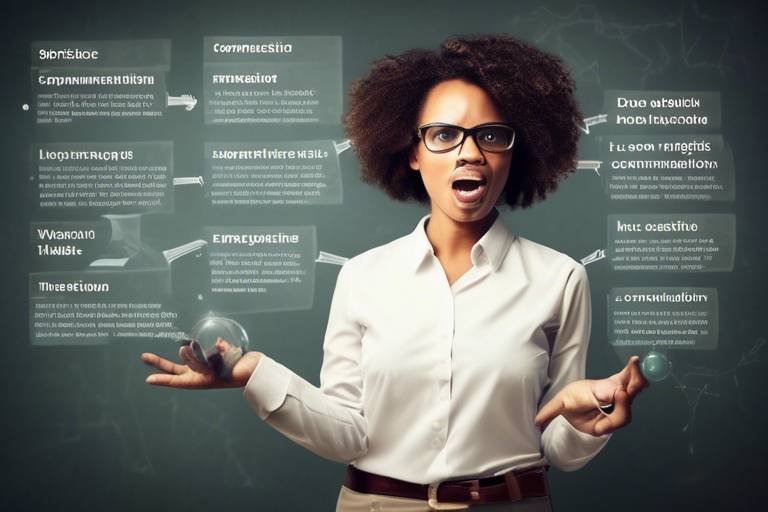The Science Behind Effective Communication
Effective communication is the bedrock of any successful relationship, whether personal or professional. It is a multifaceted process that involves not just the words we speak, but also the emotions, intentions, and context behind those words. Think of communication as a dance; it requires rhythm, timing, and an understanding of your partner's movements. Just like in a dance, where one misstep can lead to confusion, poor communication can create misunderstandings and conflict. But what exactly makes communication effective? This article dives deep into the psychological, social, and neurological aspects of communication, offering you practical tips to enhance your interpersonal skills and foster a greater understanding with others.
At its core, effective communication is about connection. It’s about creating a bridge between minds and hearts, allowing for the exchange of ideas, feelings, and perspectives. When we communicate effectively, we not only convey our message clearly but also ensure that it resonates with the listener. This requires an understanding of various elements, including verbal and nonverbal cues, the ability to listen actively, and a genuine sense of empathy. Each of these elements plays a vital role in shaping the communication experience.
Moreover, the neurological underpinnings of communication reveal fascinating insights into how our brains process information. When we communicate, our brains are constantly evaluating and interpreting signals from our environment. This includes not only the words we hear but also the tone of voice, body language, and even the emotional state of the speaker. Understanding these aspects can significantly enhance our communication skills, allowing us to connect more deeply with others.
In today's fast-paced world, where technology often mediates our interactions, it’s crucial to recognize the importance of effective communication. The digital age has transformed the way we connect, offering both advantages and challenges. While technology facilitates instant communication, it can also lead to misunderstandings due to the lack of nonverbal cues. Thus, mastering the art of communication is more important than ever, as it empowers us to navigate both personal and professional relationships with confidence and clarity.
As we explore the principles of effective communication, we will delve into various strategies and techniques that can enhance our skills. From understanding the importance of nonverbal communication to mastering active listening techniques, each section of this article aims to provide you with actionable insights. By the end, you'll not only grasp the science behind effective communication but also be equipped with the tools to improve your interpersonal interactions significantly.
- What is effective communication?
Effective communication is the ability to convey information clearly and understandably, ensuring that the message is received as intended. - Why is nonverbal communication important?
Nonverbal communication, such as body language and facial expressions, often conveys more meaning than words alone, helping to reinforce or contradict verbal messages. - How can I improve my listening skills?
Practicing active listening techniques, such as maintaining eye contact and summarizing what the speaker has said, can significantly enhance your listening abilities. - What role does empathy play in communication?
Empathy allows individuals to connect on a deeper level, fostering understanding and compassion in conversations.

The Importance of Nonverbal Communication
When we think about communication, our minds often jump straight to the words we say. However, did you know that a staggering 93% of communication is nonverbal? Yes, you heard that right! Nonverbal cues, such as body language, facial expressions, and gestures, can speak volumes and often convey more than words themselves. It's like the hidden language of the heart, revealing emotions and intentions that might not be articulated verbally. Imagine having a conversation with someone who is nodding enthusiastically yet has their arms crossed tightly; the mixed signals can be confusing, right? That’s the power of nonverbal communication!
Understanding nonverbal communication is crucial for enhancing the effectiveness of our interactions. For instance, a warm smile can instantly make someone feel welcomed, while a frown can create a barrier. Body language can indicate whether a person is open to conversation or closed off. Consider the difference between leaning in while someone speaks versus leaning back with crossed arms; the former shows interest and engagement, while the latter suggests disinterest or defensiveness. By being aware of these cues, we can adapt our communication strategies to foster better connections.
Let's break down some key aspects of nonverbal communication:
- Facial Expressions: Our faces can express countless emotions, often more effectively than words. A raised eyebrow can indicate skepticism, while a genuine smile conveys warmth and friendliness.
- Gestures: Hand movements can emphasize points or express enthusiasm. However, gestures can vary significantly across cultures, so it's essential to be aware of context.
- Posture: How we hold ourselves can communicate confidence or insecurity. Standing tall with shoulders back can convey authority, while slouching may suggest a lack of confidence.
- Eye Contact: Maintaining eye contact can show attentiveness and honesty, but too much can feel intimidating. Striking a balance is key!
In essence, nonverbal communication is like the glue that holds our verbal messages together. It adds depth and meaning, making our interactions richer and more engaging. So, the next time you're in a conversation, pay close attention to not just what is being said, but how it's being said. You might find that the unspoken words carry just as much weight—if not more—than the spoken ones.
Understanding the significance of nonverbal cues can also lead to improved relationships, both personal and professional. For example, in a workplace setting, being aware of your colleagues' nonverbal signals can help you gauge their feelings and reactions, allowing for more effective teamwork. In personal relationships, recognizing and responding to nonverbal signals can deepen connections and foster empathy.
In conclusion, nonverbal communication is an essential component of our interactions. By honing our awareness of these cues and adapting our behaviors accordingly, we can enhance our communication skills and foster deeper, more meaningful connections with those around us.
- What is nonverbal communication? Nonverbal communication refers to the transmission of messages or signals without the use of words, including body language, gestures, facial expressions, and eye contact.
- Why is nonverbal communication important? It plays a crucial role in conveying emotions and intentions, often providing context that words alone cannot express.
- How can I improve my nonverbal communication skills? You can improve by being more aware of your body language, practicing active listening, and observing others' nonverbal cues during conversations.
- Can nonverbal communication vary between cultures? Yes, nonverbal cues can differ significantly across cultures, so it’s important to be aware of cultural differences when communicating.

Active listening is not just about hearing words; it’s about truly engaging with the speaker. Imagine you're at a concert, and the music is so loud that you can barely hear your friend talking next to you. That’s what passive listening feels like—just noise in the background. Instead, active listening is like being front row at that concert, where each note resonates with you, and you can feel the energy of the performance. So, how can we transform our listening skills from passive to active? Let’s dive into some effective techniques!
First and foremost, maintaining eye contact is crucial. When you look someone in the eye, it shows that you are present and invested in the conversation. It’s like a silent agreement that says, “I’m here with you.” But remember, it’s not just about staring; it’s about creating a comfortable connection. You can also nod occasionally to show understanding, which acts as a subtle encouragement for the speaker to continue.
Another key aspect of active listening is reflecting back what you’ve heard. This means paraphrasing or summarizing the speaker’s words to confirm your understanding. For example, if a friend shares their frustrations about work, you might say, “It sounds like you’re feeling overwhelmed with your projects.” This not only clarifies your comprehension but also validates their feelings, making them feel heard and appreciated.
Asking open-ended questions is another powerful technique. Instead of yes-or-no questions, try to ask questions that require more thought and elaboration. For instance, instead of asking, “Did you like the movie?” you could ask, “What did you think about the character development in the movie?” This invites the speaker to share their insights and encourages a deeper conversation.
Additionally, eliminating distractions is vital. In our fast-paced world, it’s easy to get sidetracked by notifications on our phones or the chatter around us. To truly listen, find a quiet space or turn off your phone. It’s like tuning a radio to the right frequency—when you eliminate static, the music comes through clearer. By focusing on the speaker, you demonstrate that their words are valuable to you.
Lastly, don’t underestimate the power of empathy. Put yourself in the speaker's shoes and try to understand their perspective. This doesn’t mean you have to agree with everything they say, but showing that you care about their feelings can bridge gaps and foster a stronger connection. You might say something like, “I can see why you’d feel that way; it must be really tough.”
In summary, active listening is a skill that can be honed with practice. By maintaining eye contact, reflecting back, asking open-ended questions, eliminating distractions, and showing empathy, you can transform your interactions and deepen your connections with others. Remember, effective communication is a two-way street, and mastering the art of listening is the first step in building meaningful relationships.
- What is active listening? Active listening is the practice of fully concentrating, understanding, responding, and remembering what is being said in a conversation.
- How can I improve my active listening skills? You can improve by practicing techniques such as maintaining eye contact, reflecting on what is said, asking open-ended questions, and eliminating distractions.
- Why is active listening important? Active listening fosters better understanding, reduces misunderstandings, and builds trust in relationships.
- Can active listening help in professional settings? Absolutely! Active listening is essential in team environments, negotiations, and client interactions as it enhances collaboration and problem-solving.

Empathy is like a bridge that connects us to others, allowing us to step into their shoes and understand their feelings and perspectives. Imagine walking through a bustling city, where every person you meet has a unique story to tell. When we practice empathy, we don’t just hear their words; we resonate with their experiences, making communication more meaningful. It’s this emotional connection that can transform a simple conversation into a profound exchange of understanding.
At its core, empathy involves not only recognizing someone else's emotions but also responding to them in a way that validates their feelings. It’s what makes conversations feel less transactional and more relational. When we show empathy, we create an environment where individuals feel safe to express themselves. This is particularly crucial in both personal and professional settings, where misunderstandings can lead to conflict and resentment. By fostering a culture of empathy, we can enhance collaboration and strengthen relationships.
To illustrate the power of empathy, consider the following scenarios:
- In the Workplace: A manager who listens to an employee's concerns about workload and acknowledges their stress fosters a supportive atmosphere. This not only boosts morale but also increases productivity.
- In Personal Relationships: When a friend shares their struggles, a response that reflects understanding—like “I can see how that would be really tough for you”—can deepen the bond between friends.
Empathy is not just a feel-good concept; it has tangible benefits. Studies have shown that empathetic communication leads to greater trust, improved conflict resolution, and enhanced teamwork. In fact, organizations that prioritize empathy often see higher employee satisfaction and lower turnover rates. It’s a win-win situation!
However, developing empathy requires practice. Here are some strategies to enhance your empathetic skills:
- **Active Observation:** Pay attention to nonverbal cues such as body language and facial expressions. These can provide insight into how someone is truly feeling.
- **Ask Open-Ended Questions:** Instead of yes or no questions, try to ask questions that encourage deeper conversation. For instance, “How did that make you feel?” can open the door to more meaningful dialogue.
- **Reflect Back:** After someone shares their thoughts, paraphrase what they’ve said to show that you’re listening and to confirm your understanding.
In conclusion, empathy is a vital component of effective communication. It allows us to connect on a deeper level, fostering trust and understanding in our interactions. By making a conscious effort to cultivate empathy, we can enhance our communication skills and build stronger, more meaningful relationships.

Trust is the bedrock of effective communication, acting as the invisible thread that weaves together relationships in both personal and professional settings. When people trust one another, they feel safe to express their thoughts, ideas, and feelings without fear of judgment or misunderstanding. But how do we cultivate this essential trust? It often begins with open and honest dialogue. When we communicate transparently, we signal to others that we value their input and are committed to fostering a collaborative environment.
One of the most effective ways to build trust is through active engagement. This means not just hearing what someone says, but truly listening and responding to their concerns. Imagine you're in a conversation where your partner shares a worry about work. Instead of merely nodding along, you might ask clarifying questions like, "What specifically worries you about the project?" This shows that you care and are invested in their feelings, which can significantly deepen trust.
Another vital aspect of building trust is consistency. When people know they can rely on you to say what you mean and mean what you say, it creates a solid foundation for trust. For instance, if you promise to follow up on a discussion or to be available for a meeting, make sure you deliver on that promise. Consistency breeds reliability, and reliability fosters trust.
Moreover, embracing vulnerability can also enhance trust. Sharing your own experiences, including mistakes and lessons learned, can make you more relatable and human. It invites others to do the same, creating a two-way street of openness. In essence, trust is a reciprocal relationship—when you show vulnerability, others are often encouraged to reciprocate.
Lastly, consider the role of
- Nonverbal Communication: Your body language, eye contact, and tone can either build or break trust. Ensure that your nonverbal cues align with your verbal messages.
- Empathy: Demonstrating understanding and compassion towards others’ feelings can significantly enhance trust. When people feel understood, they are more likely to trust you.
In conclusion, building trust through communication is not a one-time effort; it's a continuous process that requires intention and practice. By engaging in open dialogue, being consistent, embracing vulnerability, and paying attention to nonverbal cues, you can foster a trusting environment that enhances your relationships and promotes effective communication.
1. How can I tell if someone trusts me?
You can often gauge trust through their body language, willingness to share personal information, and how openly they communicate with you. If they seek your opinions and seem comfortable discussing their thoughts, it’s a good sign of trust.
2. What should I do if trust has been broken?
Rebuilding trust takes time and effort. Start by acknowledging the breach, apologizing sincerely, and demonstrating through consistent actions that you are committed to restoring the relationship.
3. Can trust be rebuilt after a significant betrayal?
Yes, while it is challenging, trust can be rebuilt after a betrayal. It requires open communication, patience, and a genuine effort from both parties to understand and heal from the situation.

Communication is like a dance; it requires both partners to be in sync to truly understand each other. However, just like in any dance, there are often missteps and barriers that can throw us off balance. These barriers can stem from various sources, including cultural differences, emotional biases, and even physical distractions. Recognizing these barriers is the first step toward overcoming them and enhancing our ability to communicate effectively.
One of the most significant barriers is cultural differences. Each culture has its own set of norms and expectations regarding communication. For instance, in some cultures, direct eye contact is a sign of confidence and honesty, while in others, it may be considered rude or aggressive. To navigate these cultural nuances, it’s essential to educate ourselves about the backgrounds of those we interact with. This can involve simple actions such as asking questions, showing genuine interest, and being open to learning. By doing so, we can create a more inclusive environment where everyone feels valued and understood.
Emotional biases also play a crucial role in how we communicate. Our feelings can cloud our judgment and affect how we interpret messages from others. For example, if someone is feeling anxious or angry, they might misinterpret a neutral comment as a personal attack. To combat this, we need to practice self-awareness and emotional regulation. When we recognize our emotional state, we can better manage our reactions and responses. This not only helps us communicate more clearly but also fosters a sense of empathy towards others who may be experiencing similar emotional challenges.
Physical distractions can also hinder effective communication. Imagine trying to have an important conversation in a bustling café or a loud office. The noise and distractions can lead to misunderstandings or missed messages. To minimize these distractions, it’s vital to choose an appropriate setting for important discussions. A quiet, comfortable environment allows for better focus and understanding. Additionally, turning off electronic devices or minimizing interruptions can significantly enhance the quality of the conversation.
In overcoming these barriers, it’s also crucial to develop strong communication skills. This includes being clear and concise in our messages, using active listening techniques, and providing constructive feedback. Here are a few strategies to consider:
- Clarify and Confirm: After someone speaks, paraphrase what they have said to ensure understanding.
- Be Open-Minded: Approach conversations with a willingness to understand different perspectives.
- Practice Patience: Give others the time they need to express themselves fully.
By actively working to overcome these barriers, we can create a more harmonious communication experience. Remember, effective communication is not just about speaking; it’s about creating a connection that fosters understanding and collaboration. As we navigate through our interactions, let’s embrace the diversity of communication styles and strive to build bridges rather than walls.
- What are some common barriers to communication? Common barriers include cultural differences, emotional biases, physical distractions, and language barriers.
- How can I improve my communication skills? You can improve by practicing active listening, being clear and concise, and seeking feedback from others.
- Why is empathy important in communication? Empathy allows us to connect with others on a deeper level, enhancing understanding and reducing misunderstandings.
- What role does the environment play in communication? The environment can affect how messages are received; a quiet, comfortable setting is often more conducive to effective communication.

In today's fast-paced world, technology has become the lifeblood of our communication. It's almost as if we live in a digital jungle, where information flows like a raging river, constantly shaping how we connect with one another. Have you ever thought about how a simple text message can convey emotions just as powerfully as a face-to-face conversation? It’s fascinating, right? Technology has not only transformed the speed of our interactions but also the very nature of our conversations.
From emails to social media platforms, technology offers us a plethora of tools to communicate. While these tools can enhance our ability to share information, they can also create a barrier between us. For instance, consider how a quick emoji can replace a thousand words in a text. However, this reliance on digital communication can lead to misunderstandings. Without the nuances of body language and tone, messages can easily be misinterpreted. It’s like trying to read a book with half the pages missing; you might get the gist, but you'll miss out on the deeper meaning.
Moreover, technology has introduced new forms of communication that cater to our busy lifestyles. Video calls allow us to connect with people across the globe as if they were sitting right next to us. However, this convenience comes with its own set of challenges. Have you ever been on a video call and felt distracted by the background noise or visual clutter? These distractions can hinder effective communication, making it essential for us to adapt our skills to suit the medium we are using.
Let’s not overlook the impact of social media. Platforms like Facebook, Twitter, and Instagram have revolutionized how we share our thoughts and experiences. They allow us to broadcast our lives to a wider audience, but at what cost? The superficial nature of online interactions can lead to a lack of genuine connection. It's like attending a party where everyone is on their phones; the atmosphere might be lively, but the real conversations are happening in the background, unheard and unnoticed.
While technology has its drawbacks, it also offers incredible opportunities for enhancing communication. Consider the role of collaborative tools like Slack or Microsoft Teams in the workplace. These platforms foster teamwork and streamline communication, allowing for instant feedback and idea sharing. However, it's essential to strike a balance; relying too heavily on these tools can lead to information overload, where the sheer volume of messages can become overwhelming.
In conclusion, technology is a double-edged sword in the realm of communication. It has the power to connect us in ways we never dreamed possible, yet it can also create barriers that hinder our ability to engage meaningfully. As we navigate this digital landscape, it's crucial to remain mindful of how we communicate. By blending the advantages of technology with the timeless principles of effective communication, we can foster deeper connections that transcend the screen.
- How has technology changed the way we communicate? Technology has accelerated the speed of communication and introduced new mediums such as social media and instant messaging, allowing for real-time interactions.
- What are the downsides of digital communication? The lack of nonverbal cues can lead to misunderstandings, and the superficial nature of online interactions may hinder genuine connections.
- Can technology enhance workplace communication? Yes, tools like Slack and Microsoft Teams facilitate collaboration and improve communication efficiency in teams.
- How can I improve my communication skills in a digital world? Focus on clarity, be mindful of your tone, and ensure you’re using the right medium for your message to foster better understanding.

When we think about communication, we often focus on what is being said, but the truth is, feedback plays a pivotal role in shaping our conversations. Imagine trying to navigate a ship without knowing where the currents are taking you; that’s what communication feels like without feedback. It's the compass that guides us, helping to ensure that our messages are not only heard but understood. Feedback is more than just a response; it’s a vital component that fosters growth and improvement in our interactions. It allows us to adjust our messages and approach based on the reactions we receive, making our communication more effective and meaningful.
In any conversation, feedback can take various forms, from verbal affirmations like "I see" or "That makes sense," to nonverbal cues such as nodding or maintaining eye contact. These signals are crucial as they indicate whether the message is resonating with the listener. When we receive feedback, we gain insights into how our words are being perceived, allowing us to refine our message in real-time. For instance, if you’re presenting an idea and notice puzzled expressions, it’s a clear sign that you might need to clarify or elaborate further. This dynamic exchange not only enhances understanding but also builds a stronger connection between the parties involved.
However, the effectiveness of feedback hinges on how it is given and received. Constructive feedback is essential—it should be specific, actionable, and delivered in a way that encourages improvement rather than discouragement. For example, instead of saying, "You did this wrong," a more constructive approach would be, "I think it would be more effective if you tried this method instead." This not only communicates the issue but also provides a pathway for improvement. It’s about creating a safe space where individuals feel comfortable sharing their thoughts without fear of judgment or backlash.
Moreover, feedback is a two-way street. It’s not just about giving feedback; it's equally important to be receptive to it. This means actively listening to what others have to say about your communication style or content. Embracing feedback can be challenging, especially if it feels critical, but it’s essential for personal and professional growth. Engaging in open dialogue about feedback can lead to deeper understanding and collaboration. For example, in a team setting, regularly scheduled feedback sessions can foster a culture of continuous improvement and innovation.
To illustrate the importance of feedback, consider the following table that highlights the differences between effective and ineffective feedback:
| Effective Feedback | Ineffective Feedback |
|---|---|
| Specific and detailed | Vague and general |
| Encourages improvement | Discourages and criticizes |
| Timely and relevant | Delayed and irrelevant |
| Promotes open dialogue | Shuts down communication |
In conclusion, feedback is not merely an afterthought in communication; it is a fundamental element that can elevate our interactions to new heights. By embracing feedback—both giving and receiving—we can create a more engaging and productive communication environment. So, the next time you find yourself in a conversation, remember that feedback is your ally. It’s the tool that helps you navigate the complex waters of communication, ensuring that your message not only reaches but resonates with your audience.
- What is the difference between feedback and criticism? Feedback is constructive and aimed at improvement, while criticism often focuses on pointing out flaws without offering solutions.
- How can I give effective feedback? Be specific, focus on behavior rather than personality, and provide actionable suggestions.
- Why is receiving feedback important? It helps you grow and improve your communication skills, allowing for better interactions in the future.

When we think about communication, it’s easy to focus solely on the words we choose. However, the context in which we communicate is equally crucial. Context encompasses a wide range of factors, including the physical environment, cultural background, the relationship between communicators, and even the emotional state of the individuals involved. Imagine trying to have a serious conversation in a noisy, crowded room versus a quiet, comfortable setting. The latter allows for deeper engagement and understanding, while the former can lead to misunderstandings and frustration.
One key aspect of context is the physical environment. The setting can greatly influence how messages are received and interpreted. For instance, a formal office space may elicit a more professional tone, while a casual coffee shop can foster a relaxed atmosphere conducive to open dialogue. This is why it’s essential to consider where you choose to communicate. Are you in a place that supports your message?
Moreover, cultural context plays a significant role in shaping communication styles. Different cultures have varying norms regarding eye contact, gestures, and even the use of silence. For example, in some cultures, maintaining eye contact is a sign of confidence and honesty, while in others, it may be seen as disrespectful. Understanding these nuances can help bridge gaps and prevent miscommunication.
Additionally, the relationship between the individuals involved is another layer of context that can affect communication. Are you speaking to a close friend, a colleague, or a superior? The dynamics of your relationship will influence the language you use, the topics you discuss, and even your body language. For instance, you might adopt a more formal tone when addressing a boss compared to a casual chat with a friend.
Emotional context is also vital. If someone is feeling stressed or upset, they might misinterpret a neutral comment as criticism. Recognizing the emotional state of both yourself and the person you’re communicating with can help you tailor your message appropriately. In this way, being attuned to context can transform a potentially awkward interaction into a meaningful exchange.
In summary, context is not just a backdrop for communication; it is an integral part of the process itself. By being mindful of the various factors that influence our interactions, we can enhance our communication skills and foster better understanding. So, the next time you find yourself in a conversation, take a moment to consider the context. Are you in the right place? Are you aware of the cultural nuances? Have you considered the emotional states at play? By asking these questions, you can significantly improve the effectiveness of your communication.
- What is the most important aspect of context in communication?
The most important aspect can vary depending on the situation, but understanding the emotional state of the individuals involved is often crucial for effective communication. - How can I improve my awareness of context?
You can improve your awareness by actively observing your surroundings, considering cultural differences, and being mindful of the emotional cues from others. - Does context always change the meaning of a message?
Yes, context can significantly alter the interpretation of a message. What may seem straightforward in one context could be misunderstood in another.

Effective group communication is like a well-oiled machine; every part needs to work together harmoniously to achieve the desired outcome. When individuals come together to discuss ideas, share knowledge, or solve problems, it's crucial to implement strategies that ensure everyone is on the same page. So, how can we make group communication not only effective but also enjoyable? Let's dive into some practical strategies that can transform your group discussions.
One of the first steps to fostering effective communication is establishing a clear agenda. Before any meeting, it's essential to outline the topics to be covered, the goals to be achieved, and the time allocated for each discussion point. This approach not only keeps the conversation focused but also ensures that everyone is prepared and knows what to expect. Imagine walking into a meeting without knowing the purpose—it's like stepping into a maze without a map!
Another critical strategy is to encourage participation from all group members. Everyone has unique insights and experiences that can enrich the conversation. To achieve this, consider using techniques such as round-robin sharing or brainstorming sessions. You can also create a safe space where individuals feel comfortable expressing their thoughts without fear of judgment. This can be as simple as setting ground rules for respectful communication. When people feel valued and heard, the group dynamic improves significantly.
Additionally, active facilitation plays a vital role in group communication. A good facilitator guides the discussion, ensuring that it flows smoothly and that all voices are heard. This person can also help to mediate conflicts and keep the conversation on track. Think of the facilitator as a conductor of an orchestra, harmonizing different instruments to create a beautiful symphony. Without this guidance, discussions can easily become chaotic, leading to misunderstandings and frustration.
Moreover, we must not underestimate the power of nonverbal cues. Body language, eye contact, and facial expressions can convey just as much, if not more, than spoken words. Being aware of these cues can help group members gauge the atmosphere of the discussion and adjust their communication style accordingly. For instance, if someone appears disengaged, it might be a sign to invite them to share their thoughts or to change the topic. Remember, communication is a two-way street!
Finally, after discussions, it’s crucial to summarize key points and outline the next steps. This recap reinforces what was discussed and ensures that everyone leaves with the same understanding. You can even designate someone to take notes and distribute them afterward, serving as a reference for future conversations. This practice not only enhances accountability but also helps in tracking progress over time.
In essence, effective group communication is about creating an environment where collaboration thrives. By implementing these strategies, you can facilitate meaningful discussions that lead to innovative solutions and stronger relationships within your team. So, the next time you gather a group, remember to set the stage for success!
- What is the most important aspect of group communication?
Active participation and a clear agenda are crucial for effective group communication. - How can I encourage quieter members to speak up?
Use techniques like round-robin sharing or create a safe space for open dialogue. - What role does nonverbal communication play?
Nonverbal cues can provide insights into how group members are feeling, enhancing understanding and engagement. - Why is summarizing important?
Summarizing ensures everyone leaves with the same understanding and reinforces accountability.
Frequently Asked Questions
- What is effective communication?
Effective communication is the art of conveying information clearly and understandably. It involves not just speaking or writing, but also listening and understanding the other person's perspective. Think of it as a dance where both partners need to be in sync to create a beautiful performance.
- Why is nonverbal communication important?
Nonverbal communication, such as body language and facial expressions, can often convey more than words themselves. It's like the icing on the cake; it enhances the overall message and can reveal true feelings that words might not express. Being aware of these cues can significantly improve how we connect with others.
- How can I improve my active listening skills?
Improving active listening skills involves focusing entirely on the speaker, avoiding interruptions, and reflecting back what you've heard. It's like tuning into your favorite radio station; you need to eliminate distractions to catch every note and nuance. Practicing this can lead to deeper connections and better understanding.
- What role does empathy play in communication?
Empathy allows us to step into someone else's shoes, fostering a deeper connection and understanding. It's like having a superpower that helps us relate to others' feelings and experiences. This shared understanding can make conversations more meaningful and productive.
- How can I build trust in my communications?
Building trust involves being honest, consistent, and open in your communications. It’s like constructing a bridge; each honest interaction adds a plank, making the bridge stronger and more reliable. Trust encourages open dialogue and makes it easier to tackle difficult conversations.
- What are some common barriers to effective communication?
Common barriers include cultural differences, emotional biases, and misunderstandings. These barriers can distort the message, much like static on a phone call. Recognizing and addressing these obstacles is key to enhancing communication.
- How has technology changed the way we communicate?
Technology has made communication faster and more accessible, but it also brings challenges like misinterpretation and a lack of personal connection. It's a double-edged sword; while we can reach anyone, anywhere, the nuances of face-to-face interactions can sometimes get lost in translation.
- What is the significance of feedback in communication?
Feedback is crucial for improving communication skills. It’s like a mirror reflecting our strengths and areas for growth. When given and received constructively, feedback can enhance understanding and foster personal and professional development.
- How does context influence communication?
Context shapes how messages are interpreted, including the environment, cultural background, and emotional state of the individuals involved. It’s like the backdrop of a play; it sets the scene and can change the audience's perception of the performance.
- What strategies can I use for effective group communication?
Effective group communication requires strategies like encouraging participation, setting clear goals, and ensuring everyone has a voice. Think of it as orchestrating a symphony; each member plays a vital role in creating harmony and achieving a common goal.



















